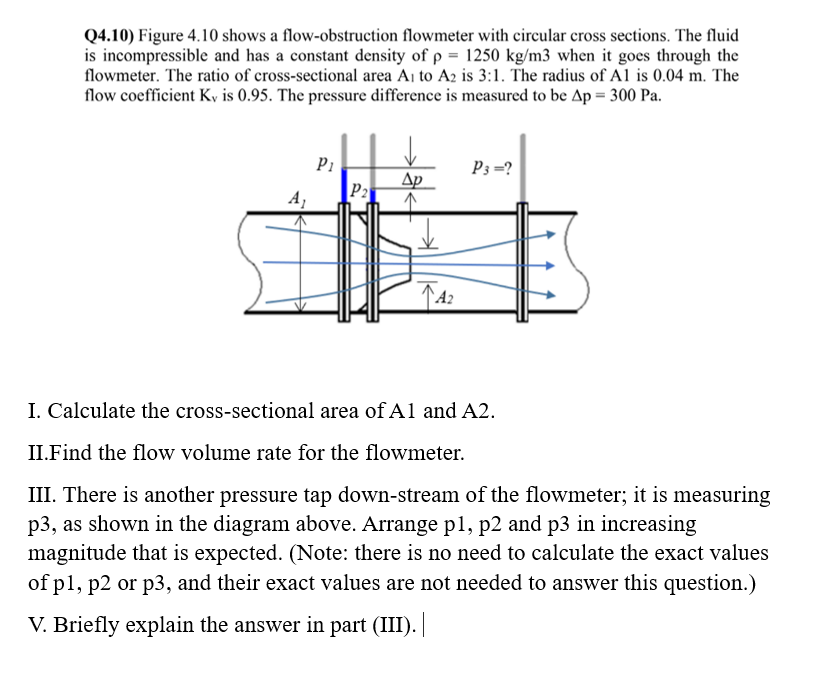Q4.10) Figure 4.10 shows a flow-obstruction flowmeter with circular cross sections. The fluid is incompressible and has a constant density of p= 1250 kg/m3 when it goes through the flowmeter. The ratio of cross-sectional area A₁ to A2 is 3:1. The radius of Al is 0.04 m. The flow coefficient Ky is 0.95. The pressure difference is measured to be Ap= 300 Pa. A₁ Pi P₂ Др ↑42 P3=? I. Calculate the cross-sectional area of A1 and A2. II.Find the flow volume rate for the flowmeter. III. There is another pressure tap down-stream of the flowmeter; it is measuring p3, as shown in the diagram above. Arrange p1, p2 and p3 in increasing magnitude that is expected. (Note: there is no need to calculate the exact values of p1, p2 or p3, and their exact values are not needed to answer this question.) V. Briefly explain the answer in part (III). |
Q4.10) Figure 4.10 shows a flow-obstruction flowmeter with circular cross sections. The fluid is incompressible and has a constant density of p= 1250 kg/m3 when it goes through the flowmeter. The ratio of cross-sectional area A₁ to A2 is 3:1. The radius of Al is 0.04 m. The flow coefficient Ky is 0.95. The pressure difference is measured to be Ap= 300 Pa. A₁ Pi P₂ Др ↑42 P3=? I. Calculate the cross-sectional area of A1 and A2. II.Find the flow volume rate for the flowmeter. III. There is another pressure tap down-stream of the flowmeter; it is measuring p3, as shown in the diagram above. Arrange p1, p2 and p3 in increasing magnitude that is expected. (Note: there is no need to calculate the exact values of p1, p2 or p3, and their exact values are not needed to answer this question.) V. Briefly explain the answer in part (III). |
Elements Of Electromagnetics
7th Edition
ISBN:9780190698614
Author:Sadiku, Matthew N. O.
Publisher:Sadiku, Matthew N. O.
ChapterMA: Math Assessment
Section: Chapter Questions
Problem 1.1MA
Related questions
Question
Hi Please answer Question V ONLY! Thanks!

Transcribed Image Text:Q4.10) Figure 4.10 shows a flow-obstruction flowmeter with circular cross sections. The fluid
is incompressible and has a constant density of p= 1250 kg/m3 when it goes through the
flowmeter. The ratio of cross-sectional area A₁ to A2 is 3:1. The radius of Al is 0.04 m. The
flow coefficient Kv is 0.95. The pressure difference is measured to be Ap = 300 Pa.
A₁
Pi
P2
Ap
↑42
A₂
P3=?
I. Calculate the cross-sectional area of A1 and A2.
II.Find the flow volume rate for the flowmeter.
III. There is another pressure tap down-stream of the flowmeter; it is measuring
p3, as shown in the diagram above. Arrange p1, p2 and p3 in increasing
magnitude that is expected. (Note: there is no need to calculate the exact values
of p1, p2 or p3, and their exact values are not needed to answer this question.)
V. Briefly explain the answer in part (III). |
Expert Solution
This question has been solved!
Explore an expertly crafted, step-by-step solution for a thorough understanding of key concepts.
Step by step
Solved in 6 steps with 3 images

Knowledge Booster
Learn more about
Need a deep-dive on the concept behind this application? Look no further. Learn more about this topic, mechanical-engineering and related others by exploring similar questions and additional content below.Recommended textbooks for you

Elements Of Electromagnetics
Mechanical Engineering
ISBN:
9780190698614
Author:
Sadiku, Matthew N. O.
Publisher:
Oxford University Press

Mechanics of Materials (10th Edition)
Mechanical Engineering
ISBN:
9780134319650
Author:
Russell C. Hibbeler
Publisher:
PEARSON

Thermodynamics: An Engineering Approach
Mechanical Engineering
ISBN:
9781259822674
Author:
Yunus A. Cengel Dr., Michael A. Boles
Publisher:
McGraw-Hill Education

Elements Of Electromagnetics
Mechanical Engineering
ISBN:
9780190698614
Author:
Sadiku, Matthew N. O.
Publisher:
Oxford University Press

Mechanics of Materials (10th Edition)
Mechanical Engineering
ISBN:
9780134319650
Author:
Russell C. Hibbeler
Publisher:
PEARSON

Thermodynamics: An Engineering Approach
Mechanical Engineering
ISBN:
9781259822674
Author:
Yunus A. Cengel Dr., Michael A. Boles
Publisher:
McGraw-Hill Education

Control Systems Engineering
Mechanical Engineering
ISBN:
9781118170519
Author:
Norman S. Nise
Publisher:
WILEY

Mechanics of Materials (MindTap Course List)
Mechanical Engineering
ISBN:
9781337093347
Author:
Barry J. Goodno, James M. Gere
Publisher:
Cengage Learning

Engineering Mechanics: Statics
Mechanical Engineering
ISBN:
9781118807330
Author:
James L. Meriam, L. G. Kraige, J. N. Bolton
Publisher:
WILEY